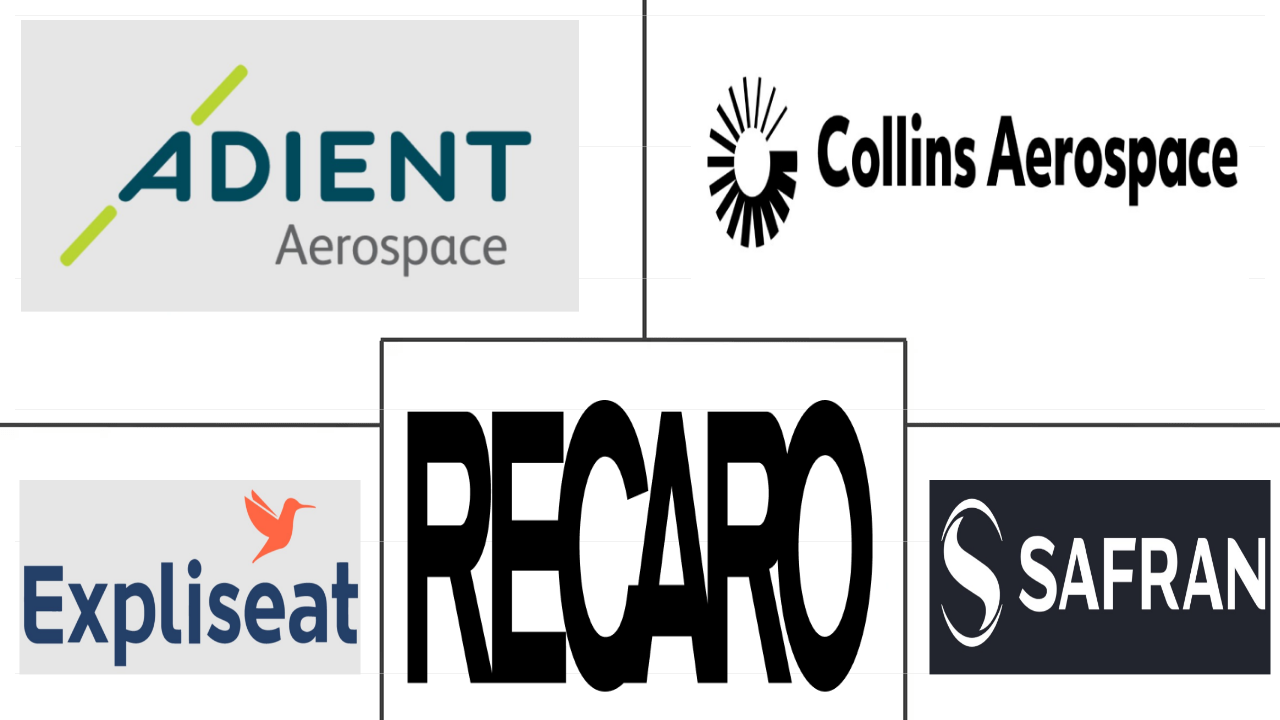Market Size of middle east commercial aircraft cabin seating Industry
|
|
Study Period | 2017 - 2030 |
|
|
Market Size (2024) | USD 359.6 Million |
|
|
Market Size (2030) | USD 503.8 Million |
|
|
Largest Share by Aircraft Type | Widebody |
|
|
CAGR (2024 - 2030) | 5.78 % |
|
|
Largest Share by Country | United Arab Emirates |
Major Players |
||

|
||
|
*Disclaimer: Major Players sorted in no particular order |
Middle East Commercial Aircraft Cabin Seating Market Analysis
The Middle East Commercial Aircraft Cabin Seating Market size is estimated at 359.6 million USD in 2024, and is expected to reach 503.8 million USD by 2030, growing at a CAGR of 5.78% during the forecast period (2024-2030).
359.6 Million
Market Size in 2024 (USD)
503.8 Million
Market Size in 2030 (USD)
-9.79 %
CAGR (2017-2023)
5.78 %
CAGR (2024-2030)
Largest Market by Aircraft Type
82.98 %
value share, Widebody, 2023
The increase in international air travel traffic flow catalyzes the demand for cabin seats in widebody aircraft operating on long-haul routes, therefore creating a demand in the European market.
Fastest-Growing Market by Aircraft Type
6.71 %
Projected CAGR, Widebody, 2024-2030
Widebody aircraft are designed primarily for long-haul flights. They have larger space to add more seats than narrowbody aircraft, resulting in the segment's rapid growth.
Largest Market by Cabin Class
71.01 %
value share, Business and First Class, 2023
The business and first classes benefit from the growing emphasis on fleet expansion, passenger amenities, and comfort.
Largest Market by Country
69.87 %
value share, United Arab Emirates, 2023
United Arab Emirates is expected to register a major revenue share during 2024-2030 due to the increasing air transportation rate and rising commercial aircraft orders from major airlines.
Leading Market Player
39.05 %
market share, Collins Aerospace, 2022

With its broad range of first-class, business-class, and economy-class passenger seats, Collins Aerospace dominates the cabin seating market in the Middle East.
Rising demand for widebody aircraft and airlines focusing on passenger comfort and privacy is expected to drive the demand for cabin seating in the Middle East
- The aviation industry in the Middle East has been steadily growing over the years, driven by increased tourism, economic development, and the expansion of airline fleets. One crucial aspect of this growth is the cabin seat market, which is pivotal in ensuring passenger comfort and airline profitability. As air travel continues to gain popularity in the Middle East, airlines constantly seek innovative ways to enhance passenger comfort and maximize seating capacity. The region's demand for cabin seating market is driven by new aircraft procured by various airlines. In terms of deliveries, widebody aircraft dominated the number of deliveries in the Middle East, with an overall share of 52% during 2017-2022.
- The adoption of narrowbody aircraft in the longer haul routes by the Middle East airlines has increased, aiding the deployment of ergonomic seats in narrowbody aircraft. The airlines such as Emirates have focused on increasing their business class seats and improving customer experience. The airlines in the region have started emphasizing the adoption of lighter seats.
- Around 543 narrowbody aircraft and 401 widebody aircraft are expected to be delivered in the region with major markets such as Saudi Arabia, Qatar, and the United Arab Emirates during 2023-2030. The fleet expansion plans in the region are expected to aid the procurement of narrowbody and widebody aircraft. This will, in turn, be expected to drive the growth of the region's commercial aircraft cabin seating market during the forecast period by 8.30%.
The UAE is expected to witness a larger growth in the region because of huge aircraft orders placed by the countries’ airlines
- Customer experience is always the top priority for airlines. Dissatisfied or disengaged customers inevitably result in fewer passengers and reduced profits for airlines. It is vital for passengers to have a positive experience whenever they travel. To provide the best experience, airlines in the Middle East are focused on modernized cabin seats that provide comfort and overall enjoyment to passengers during their travel. Airlines in the Middle East have started adopting lighter seats for a reduction in the overall weight of aircraft. This upgrade will also improve efficiency and promote better utilization of cabin spaces.
- The demand for the aircraft cabin seating market in the region is driven by aircraft orders that are being placed by various airlines as part of fleet renewal and the need for long-range, fuel-efficient aircraft. Some of the major airlines, such as Air Arabia, Emirates, Etihad, Qatar Airways, Saudia, Riyadh Air, and Flydubai, have ordered a total of 391 narrowbody and 413 widebody aircraft. Of these total aircraft ordered, the UAE's top airlines, such as Emirates, Etihad, and Flydubai, have ordered 361 aircraft. The UAE is expected to witness a larger growth driven by its huge aircraft orders. These ordered aircraft are expected to be delivered throughout the forecast period, and these aircraft orders are expected to drive the demand for aircraft seating market. The Middle East is expected to see enormous expansion over the next 20 years, requiring a fleet of around 3,400 jets to serve fast-growing passenger traffic, according to Boeing. Factors such as these are expected to drive the demand in the region's aircraft seat market by 8.30% during 2023-2030.
Middle East Commercial Aircraft Cabin Seating Industry Segmentation
Narrowbody, Widebody are covered as segments by Aircraft Type. Saudi Arabia, United Arab Emirates are covered as segments by Country.
- The aviation industry in the Middle East has been steadily growing over the years, driven by increased tourism, economic development, and the expansion of airline fleets. One crucial aspect of this growth is the cabin seat market, which is pivotal in ensuring passenger comfort and airline profitability. As air travel continues to gain popularity in the Middle East, airlines constantly seek innovative ways to enhance passenger comfort and maximize seating capacity. The region's demand for cabin seating market is driven by new aircraft procured by various airlines. In terms of deliveries, widebody aircraft dominated the number of deliveries in the Middle East, with an overall share of 52% during 2017-2022.
- The adoption of narrowbody aircraft in the longer haul routes by the Middle East airlines has increased, aiding the deployment of ergonomic seats in narrowbody aircraft. The airlines such as Emirates have focused on increasing their business class seats and improving customer experience. The airlines in the region have started emphasizing the adoption of lighter seats.
- Around 543 narrowbody aircraft and 401 widebody aircraft are expected to be delivered in the region with major markets such as Saudi Arabia, Qatar, and the United Arab Emirates during 2023-2030. The fleet expansion plans in the region are expected to aid the procurement of narrowbody and widebody aircraft. This will, in turn, be expected to drive the growth of the region's commercial aircraft cabin seating market during the forecast period by 8.30%.
| Aircraft Type | |
| Narrowbody | |
| Widebody |
| Country | |
| Saudi Arabia | |
| United Arab Emirates | |
| Rest of Middle East |
Middle East Commercial Aircraft Cabin Seating Market Size Summary
The Middle East Commercial Aircraft Cabin Seating Market is experiencing significant growth, driven by the expanding aviation industry in the region. This growth is fueled by increased tourism, economic development, and the expansion of airline fleets, which necessitate advancements in cabin seating to enhance passenger comfort and airline profitability. The demand for cabin seating is primarily driven by new aircraft procurements, with a notable focus on both narrowbody and widebody aircraft. Airlines such as Emirates are prioritizing the enhancement of business class seats and the adoption of lighter, ergonomic seats to improve customer experience and optimize cabin space utilization. The region's strategic position as a major international travel hub further amplifies the need for modernized cabin interiors, as airlines aim to cater to the growing passenger traffic and maintain competitive advantage.
The market is characterized by a robust pipeline of aircraft deliveries, with major airlines in countries like Saudi Arabia, Qatar, and the United Arab Emirates leading the charge. The procurement of new aircraft is expected to drive the demand for advanced cabin seating solutions, as airlines focus on fleet renewal and the need for long-range, fuel-efficient aircraft. The Middle East's aviation sector has shown resilience and rapid recovery post-COVID-19, with air passenger traffic rebounding strongly. This recovery is anticipated to continue, with significant growth in air travel expected over the next two decades. The market is fragmented, with key players such as Adient Aerospace, Collins Aerospace, Expliseat, Recaro Group, and Safran playing pivotal roles in shaping the future of cabin seating in the region.
Middle East Commercial Aircraft Cabin Seating Market Size - Table of Contents
-
1. MARKET SEGMENTATION (includes market size in Value in USD, Forecasts up to 2030 and analysis of growth prospects)
-
1.1 Aircraft Type
-
1.1.1 Narrowbody
-
1.1.2 Widebody
-
-
1.2 Country
-
1.2.1 Saudi Arabia
-
1.2.2 United Arab Emirates
-
1.2.3 Rest of Middle East
-
-
Middle East Commercial Aircraft Cabin Seating Market Size FAQs
How big is the Middle East Commercial Aircraft Cabin Seating Market?
The Middle East Commercial Aircraft Cabin Seating Market size is expected to reach USD 359.57 million in 2024 and grow at a CAGR of 5.78% to reach USD 503.81 million by 2030.
What is the current Middle East Commercial Aircraft Cabin Seating Market size?
In 2024, the Middle East Commercial Aircraft Cabin Seating Market size is expected to reach USD 359.57 million.

